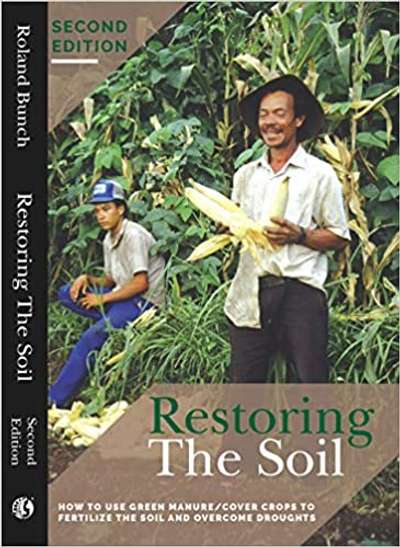
Now available through Amazon as well as the ECHO Bookstore
Smallholder farmers around the world face some of the harshest growing conditions globally, yet they produce the majority of the world’s food. Soils in these areas often lack nutrient and water holding capacities, due to erosion or poor soil structure. These obstacles can be staggering for farmers who depend on soils to sustain their crops for home and/or market production.
Bunch stated the following about soil health options for smallholder farmers:
Now that fallowing has largely died around the world because of population pressures on the land, the only feasible way smallholder farmers can save their soils from eventual degradation is by using green manure/cover crops [gm/ccs]. Composting the soil enough to maintain fertility on just one hectare of land would take months of work, and smallholder farmers do not have enough animal manure to do the job. Synthetic fertilizers often cost more than the value of the increased yield they produce when used on degraded soils or in droughty climates, and cannot provide benefits beyond supplying plant nutrients.

Figure 12. A portion of one decision tree used to help readers select gm/cc systems throughout Bunch’s book. The book includes commentary about each entry on the decision tree.
Source: Restoring the Soil, Second Edition
Roland Bunch has worked in agricultural development for more than 42 years in more than 50 nations of Latin America, Africa and Asia. He has done consultancies with the Ford Foundation, Cornell University, CARE and the top non-governmental organizations from Canada, Great Britain, the Netherlands, Germany and Switzerland, as well as the governments of Guatemala, Honduras, Swaziland and Vietnam. In 1982, he published the best-selling book Two Ears of Corn, A guide to People-Centered Agricultural Improvement.
Starting in 1983, Bunch began investigating the use of plants that are particularly good at fertilizing the soil, which are now called gm/ccs. Together with an independent group of agronomists in southern Brazil, he spearheaded the effort that successfully put this technology on the agenda of development organizations around the world. Bunch has also collaborated with ECHO since 1983.
Bunch has been nominated for the Global 500 Award, the End the Hunger Prize of the President of the United States, and the World Food Prize.
Roland Bunch's second edition of Restoring the Soil explains how gm/ccs can double or triple smallholder farmers' basic grain yields, fix more nitrogen than any smallholder farmer will need, provide up to 80% protection against droughts, provide high-protein food for the farm family, produce dry-season fodder for animals, produce tons of firewood, and sequester more atmospheric carbon at less cost than any other process we know of.

Figure 13. An example of a system description box with its accompanying image. Source: Restoring the Soil, Second Editio
Part 1 of the book describes benefits and limitations of gm/ccs, common misconceptions, and common mistakes made in using them. It discusses how gm/ccs relate to soil improvement, tropical agriculture, and climate-smart practices. Part 2 leads the reader through a unique, incremental decision-making process for selecting which of 117 gm/cc systems have the most potential for success in their setting. Figure 12 shows a portion of one decision tree; each number is accompanied by commentary in the book. Figure 13 shows an example of a system.
To order your own copy of Restoring the Soil, Second Edition, please visit the ECHO bookstore website or Amazon.com. For questions about ordering, please contact ECHO at +1 (239) 543-3246.
This is a great opportunity to learn from a world-renowned expert how to increase the health and resilience of soils around the world!
I have read Roland's book several times and I believe that it is one best resources I have ever seen for farmers of any scale from smallholders to broadacre to rebuild soil, fertility and productivity at minimal cost. We really need to promote it. As a farmer I can state with great confidence that these systems work as I have used these types of green manures for decades and still do.
- Andre Leu
Detail Penerbitan
- Terbit: 2019
- Penerbit: ECHO, Inc.
- ISBN-13: 9781946263308
- Dewey Decimal: 631.874
- Perpustakaan ECHO: 631.874 BUN